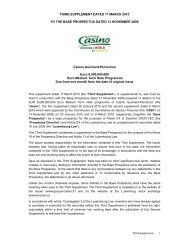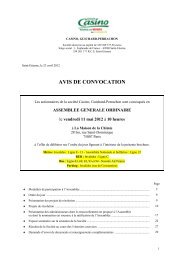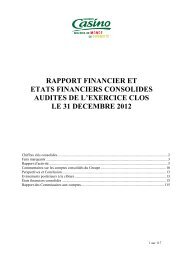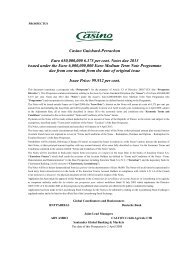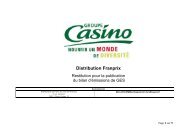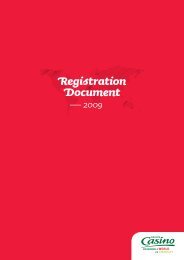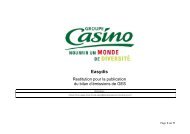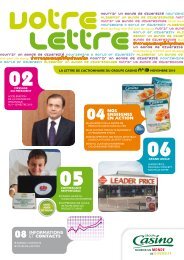2010 REGISTRATION DOCUMENT (3.4 Mo) - Groupe Casino
2010 REGISTRATION DOCUMENT (3.4 Mo) - Groupe Casino
2010 REGISTRATION DOCUMENT (3.4 Mo) - Groupe Casino
Create successful ePaper yourself
Turn your PDF publications into a flip-book with our unique Google optimized e-Paper software.
3CONSOLIDATED FINANCIAL STATEMENTSNotes to the consolidated fi nancial statementsNote 1.5.18.4. Options on treasury sharesOptions on treasury shares are treated as derivative instruments, equityinstruments or financial liabilities depending on their characteristics.Options classified as derivatives are measured at fair value throughprofit or loss. Options classified as equity instruments are measured inequity at their initial amount and changes in value are not recognised.The accounting treatment of financial liabilities is described in note1.5.14.Note 1.5.18.5. Share-based paymentThe management and certain employees of the Group receive stockoptions and share grants.The fair value of the options at the grant date is recognised in employeebenefits expense over the option vesting period. The fair value ofoptions is determined using the Black & Scholes option pricing model,based on the plan attributes, market data (including the market priceof the underlying shares, share price volatility and the risk-free interestrate) at the grant date and assumptions concerning the probability ofgrantees remaining with the Group until the options vest.The fair value of share grants is also determined on the basis ofthe plan attributes, market data at the grant date and assumptionsconcerning the probability of grantees remaining with the Group untilthe shares vest. If there are no vesting conditions attached to theshare grant plan, the expense is recognised in full when the plan isset up. Otherwise the expense is deferred over the vesting period asand when the vesting conditions are met.Note 1.5.19. ProvisionsNote 1.5.19.1. Post-employment and other long-termemployee benefi tsGroup companies provide their employees with various employeebenefit plans depending on local laws and practice.Under defined contribution plans, the Group pays fixed contributionsinto a fund and has no obligation to pay further contributions if the funddoes not hold sufficient assets to pay all employee benefits relatingto employee service in the current and prior periods. Contributionsto these plans are expensed as incurred.Under defined benefit plans, the Group’s obligation is measured usingthe projected unit credit method based on the agreements effectivein each entity. Under this method, each period of service gives riseto an additional unit of benefit entitlement and each unit is measuredseparately to build up the final obligation. The final obligation is thendiscounted. The actuarial assumptions used to measure the obligationvary according to the economic conditions prevailing in the relevantcountry. The obligation is measured by independent actuaries annuallyfor the most significant plans and for the employment terminationbenefit, and regularly for all other plans. Assumptions include expectedrate of future salary increases, estimated average working life ofemployees, life expectancy and staff turnover rates.Actuarial gains and losses arise from the effects of changes in actuarialassumptions and experience adjustments (differences between resultsbased on previous actuarial assumptions and what has actuallyoccurred). All gains and losses arising on defined benefit plans arerecognised immediately in equity.Past service cost is the increase in the obligation resulting from theintroduction of, or changes to, benefit plans. It is recognised as anexpense on a straight-line basis over the average period until thebenefits become vested, or immediately if the benefits are alreadyvested.Expenses related to defined benefit plans are recognised in operatingexpenses (service cost) and in “Other financial income and expense”(interest cost and expected return on plan assets).Curtailments, settlements and past service costs are recognisedin operating expenses or in “Other financial income and expense”depending on their nature. The liability recognised in the balance sheetis measured as the net present value of the obligation, less the fairvalue of plan assets and unrecognised past service cost.Note 1.5.19.2. Other provisionsA provision is recorded when the Group has a present obligation(legal or constructive) as a result of a past event, the amount ofthe obligation can be reliably estimated and it is probable that anoutflow of resources embodying economic benefits will be requiredto settle the obligation. Provisions are discounted when the relatedadjustment is material.In accordance with the above principle, a provision is recorded forthe cost of repairing equipment sold with a warranty. The provisionrepresents the estimated cost of repairs to be performed during thewarranty period, as estimated on the basis of actual costs incurredin prior years. Each year, part of the provision is reversed to offsetthe actual repair costs recognised in expenses.A provision for restructuring is recorded when the Group hasa constructive obligation to restructure. This is the case whenmanagement has drawn up a detailed, formal plan and has raised avalid expectation in those affected that it will carry out the restructuringby announcing its main features to them before the period-end.Other provisions concern specifically identified liabilities andcharges.Contingent liabilities correspond to possible obligations that arisefrom past events and whose existence will be confirmed only bythe occurrence or non-occurrence of one or more uncertain futureevents not wholly within the Group’s control, or present obligationswhose settlement is not expected to require an outflow of resourcesembodying economic benefits. Contingent liabilities are not recognisedin the balance sheet, but are disclosed in the notes to the financialstatements.Note 1.5.20. Put options granted to ownersof non-controlling interestsThe Group has granted put options to the owners of non-controllinginterests in some of its subsidiaries. The exercise price may befixed or based on a predetermined formula and the options may beexercised either at any time or on a fixed future date. Options with afixed exercise price are measured and recorded as financial liabilitiesat discounted present value and options with a variable exerciseprice at fair value.In accordance with IAS 32, the obligations under these puts havebeen recognised as financial liabilities.IAS 27R, which is applicable as of 1 January <strong>2010</strong>, sets out theaccounting treatment for acquisitions of additional equity interests.The Group has decided to apply two different accounting methodsdepending on whether the put options were granted before or afterthe effective date of IAS 27R, as recommended by France’s securitiesregulator (Autorité des Marchés Financiers). Put options granted beforethe effective date are accounted for using the goodwill method andthose granted after the effective date are treated as equity transactions(i.e. transactions with owners in their capacity as owners).70 <strong>Casino</strong> Group | Registration Document <strong>2010</strong>



